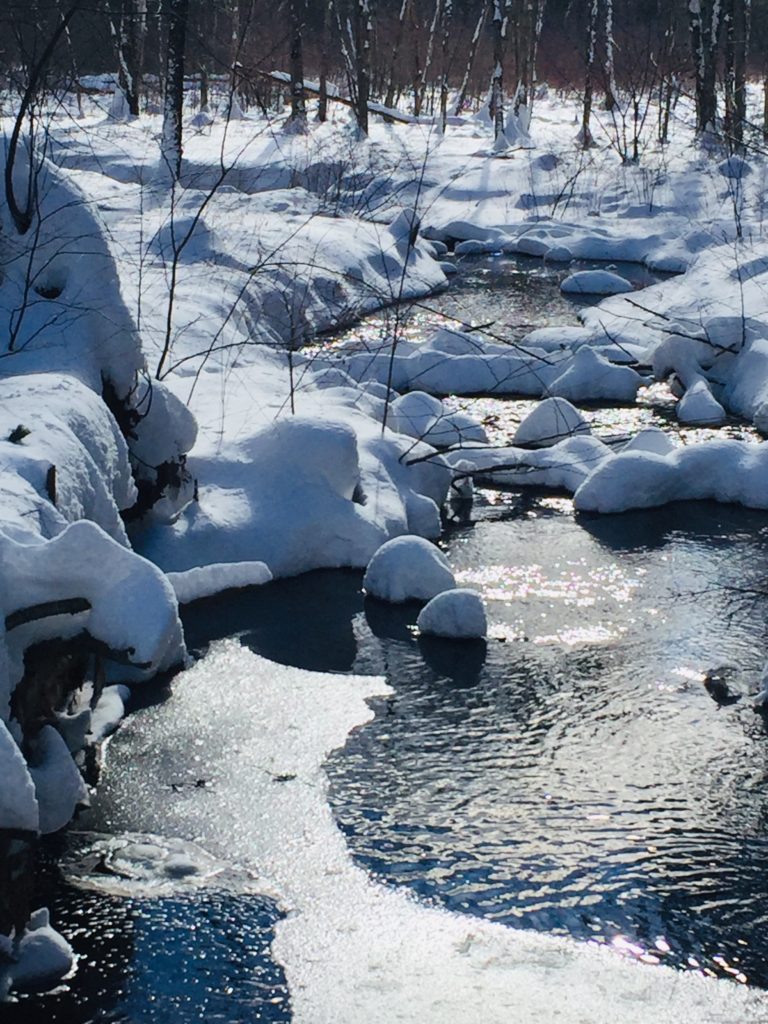
Posts may contain links to products and services I love. I may make a small commission from them, at no extra cost to you. Thank you for supporting my blog.
Pro’s Guide to Winter Hiking Trips
You have choices in the winter. Stay inside and binge watch Netflix or venture out in the cold for an exhilarating winter hike. Both have merits but since I know more about winter hiking tips than prolonged screen comfort, I’ll address the latter. These proven winter hiking tips will make you enjoy getting outside in the cold.
I’ve led winter hiking and camping trips for decades. Some have been epic such as the two and a half weeks straight spent outside winter camping in Yellowstone with 8 students. With nighttime temperatures down to minus 30 F. there were a lot of fingers and toes to be responsible for keeping unfrozen. Then working winter outdoor programs in the icebox of northern Minnesota, I learned about cold weather physiology and adaptations that can serve as a foundation to understand how to stay warm. For example, what to do in minus 70 F. windchill days. (Correct answer: binge watch and save your face from instant frostbite).
WISE Dress for Winter Hiking
Dressing properly for winter activities outdoors will make you more comfortable and safer. Your aim in staying warm during cold weather activity is to stay dry because any moisture near your skin cools and steals heat. Since sweat is not your friend, your active venting of moisture away from your core while you move is key. Layers are the answer to this balance. I use the acronym WISE to guide my dressing for success outdoors.
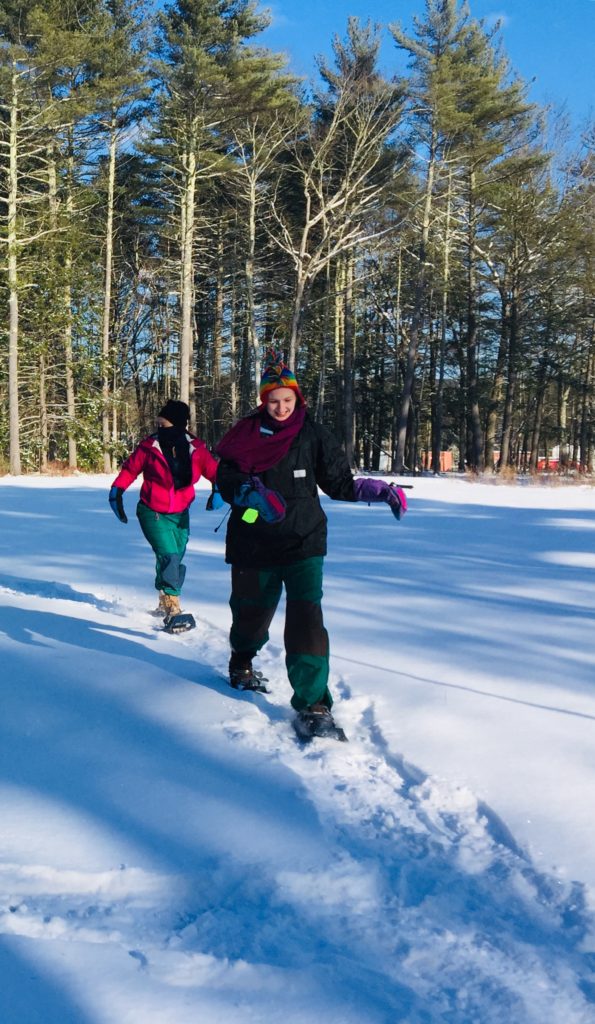
W is for Wicking
The wicking layer is closest to your skin and tends to be snug and thin. Your sweat moves through the fibers of this layer without being absorbed. Long underwear made out of non-absorbent fibers such as polypropylene/polyester, merino wool, or silk work well. Cotton doesn’t. My mantra is “Cotton Kills” as it absorbs moisture and holds it close to your body serving as a dangerous conduit of heat from your core. So save your flannel shirt or cotton sweatshirt for après ski fashion.
I is for Insulating
The insulating layer traps warm air to keep you toasty. It can be fleece, down, microfiber, or the old wool sweater handed down from your grandmother. It’s important that it has some bulk to ward off the cold air and retain the warmed-up air that escaped your wicking layer. This layer is loose and puffy for the best results. Names you’ll hear for these fabrics include Polartec, PrimaLoft, or goose down. You can save some money on this layer by visiting a thrift store that has loads of cozy synthetic fleeces available.
S is for Shell
The shell is the waterproof or windproof layer on top that keeps the elements out of your clothing and holds in the warmth. Breathable waterproof shells with armpit zippers are the best in precipitation situations. Examples include Gore-Tex or any number of proprietary company names for similar material such as DryVent or H2No. The fabric names change all the time but any reputable outdoor gear company has a good one. Coated nylon is also used for raincoats and, while a more economical alternative, you sacrifice breathability. I prefer a wind shell in winter conditions when there is no chance of rain or wet snow. I find the wind gear much more breathable so sweat isn’t trapped to make me wet and cold.
A quick way to tell the breathability of an outdoor garment is to do the “kiss test”. Grab a sleeve of the coat and try to suck air through the material. The easier the air goes through, the more breathable the garment.
E is for Extra
An extra layer stashed in your daypack allows you to fine-tune your clothing system as your personal temperature adjusts with activity or conditions change. I like to have a down coat that goes over everything to throw on when I stop for a snack break and start to get chilled.
The WISE system can also be used when thinking about your lower body, your hand, and your foot systems. For example, WISE foot covering would be a thin silk or polypropylene Wicking liner sock covered with a thicker Insulating merino wool or synthetic sock. Your waterproof winter boots are your Shell layer with an extra pair of socks in your daypack as your Extra.

Remember that your adventures will be much more fun if you use the proven winter hiking tips of dressing WISEly.

Staying Hydrated on a Winter Hike
Now that you have learned how to dress for success in the winter using the WISE layering system, let’s talk about drinking. Water, that is.

Hydration is essential to safe winter hiking or skiing. As much as you thirst for water in the summer, you actually need to drink more liquids during winter activities. That’s because you expend moisture when you breathe in the cold dry air. It’s why your buff covering your mouth and nose gets soaked. Exertion causes even more moisture loss (even if you are following the WISE guidelines).
Plus, due to the physiology of cold weather adaptation, your brain tells your body to pull blood back into your core for warmth. You’ll notice this vasoconstriction because your fingers and toes get cold. The irony is that your brain detects increased blood volume around your vital organs, thinks that you are hydrated, so turns off your thirst response, even though you need to drink more. Finally, it’s psychologically no fun to drink cold water in the winter.

Water bottle tips
So let’s make hydrating in the winter easier. Start with the water bottle. You’ll need a wide mouth liter bottle to avoid icing near the neck. Nix the hydration bladder unless you want a frozen rope sticking out of your daypack.
To keep your water bottle from freezing, put it in a thick sock or an insulated holder designed for winter use. Also, store your water bottle upside down in your pack to avoid the lid being frozen shut. Water freezes top to bottom (think about how a lake freezes over) so an upside-down bottle will prevent ice-up at the opening. If you end up with a frozen lid, stick it in your armpit to thaw. It works wonders. Don’t use hot water to loosen a frozen lid as it will compound the problem by refreezing quickly.

I like to bring along a hot drink thermos but it’s heavy and doesn’t provide the volume of liquid needed. Therefore it should supplement but never substitute for the good old fashion insulated water bottle I take out. I also drink a lot of liquids before I venture out in the cold to avoid carrying the 3-6 liters you need to drink during a full day of winter activity.
If you need to replenish your water in the backcountry, make sure to purify it. This post has informative tips on water filtration in the backcountry.
Check your hydration
Finally, let’s talk pee. Due to the aforementioned cold weather physiology, you will notice you need to pee more on a winter outdoor outing. That doesn’t mean you are hydrated properly. Checking the color of your pee in the snow is the way to determine good hydration. The less yellow, the better. Clear is ideal. Drink with that goal in mind.
Winter Hiking Tips Using Spiky Tips
Unless you like to slip slide away, spiky things are your ally in staying upright on icy trails. I’ll talk about three kinds: hiking poles, microspikes, and snowshoes with crampons.
Hiking poles
Hiking poles (aka trekking poles) work well to keep your balance in slippery conditions, especially climbing up or down. However, there are several schools of thought about their usage.
Pros:
They can prevent falls. If the trail is uneven, steep, or with blowdowns, I’ll always use my poles. I find them more cumbersome while snowshoeing or on flat trails without ice. Using hiking poles can protect your knees particularly on rocky downhills with big step-downs. Finally, you can use a pole to probe ice in streams or lakes to determine its thickness.
Cons:
They’re pricey—if you are just going to use trekking poles in the winter, stick to ski poles which are cheaper and often have a basket designed for snow.
Using poles is an upper body workout creating body heat. You will need to ventilate more to compensate to stay dry. In addition, you can’t take trekking poles in your carry-on the plane—I’ve tried—it’s a no-no.
My favorite trekking poles that I use for all-season hiking are Black Diamond Trail Pro Shock Poles. The flick locks make them super easy to adjust. Plus, the foam grip and shock absorbing feature make them really comfortable.
Microspikes
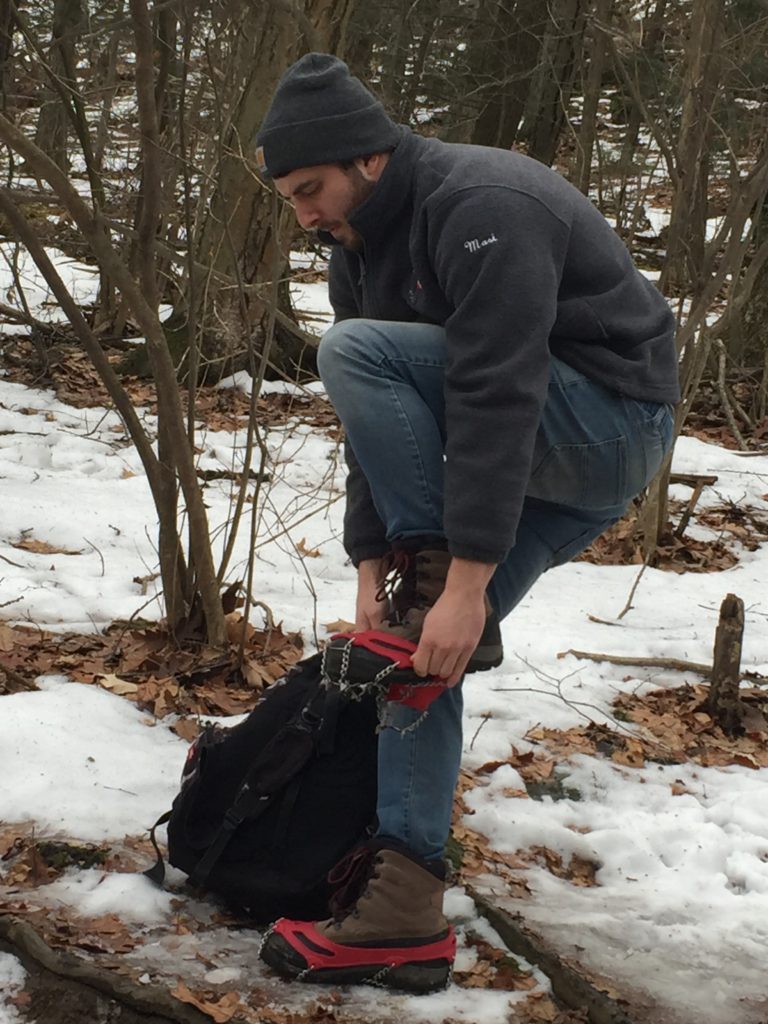
These little sharp points for your feet will make you feel like Spiderman on an icy slope. There are a variety of shoe crampons depending on your use. If you want to stay upright on a walk to the mailbox, spike-less cleats such as YAKTRAX work well. For hiking, backpacking, or nontechnical mountain climbing, I recommend microspikes with stainless steel chains and spikes underfoot. The loose chain/spike design prevents snow from clumping up and creates very sure-footed traction on ice or packed trails. Look for microspikes that go on and off easily with a flexible rubber harness. I’ve used Kahtoola MICROspikes for years and swear by them. They have kept me out of plaster casts after an ice storm and taken me up many a hard-packed trail in the mountains.
Snowshoes
With deeper snow you will need snowshoes to keep from breaking through the snow (called post holing). Snowshoeing is the responsible way to keep the trail in good shape for the next hiker or skier. I once took a group on a walk-up peak in the White Mountains without snowshoes. While the snow wasn’t too deep and the trail was tracked out, the occasional post holing we did ruined the trail for the backcountry skiers we met along the way. Lesson learned.
Selecting snowshoes requires tradeoffs. The bigger the snowshoe deck, the more afloat you will stay on soft snow. However, smaller, more stream-lined snowshoes are better for cruising on trails and through brush but don’t float as much. Therefore, take into account your usage and the type of snow in your hiking areas. For icy or packed trails with some uphill, smaller snowshoes with beefy crampons work well. For powder snow, go with a bigger deck. I use MSR Evo snowshoes because they are super easy to get on and perform in both hiking and climbing snow conditions. They have full-length traction and enough crampon power to take on the ice-plated trails common in hiking in New England. Yet, they float surprisingly well in powder, especially if you add the snap-on flotation tails. Finally, they are comparatively cheap for a quality product.
The act of snowshoeing itself is relatively straight forward. You’ll use a shuffle pace by lifting your knee so the tail of the snowshoe stays down. In icy terrain, set the claw-like crampon under your foot with some assertiveness to get traction. Finally, remember this winter hiking tip. You have a right and a left snowshoe, therefore, the buckles should be on the outside to prevent them from striking each other and interfering with your hiking.
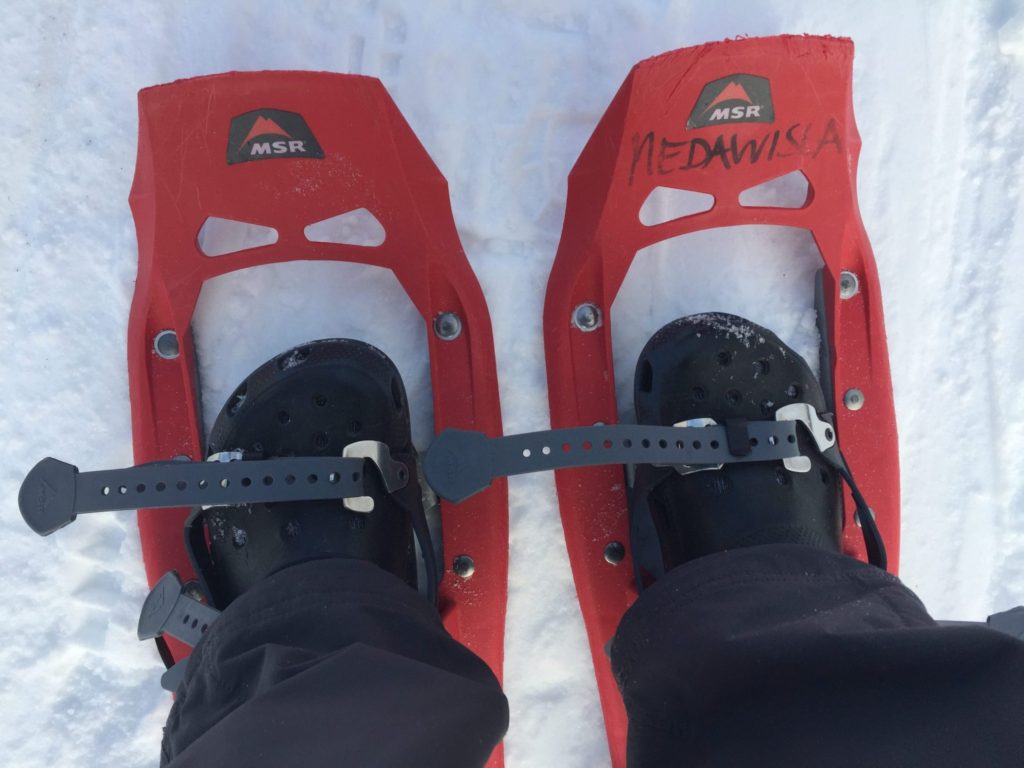
Winter Hiking Tips and Techniques
Now that keeping warm, hydrated and winter hiking gear has been covered, I’ll share some winter hiking tips and techniques that I use on the trail.
Walk like a penguin

When you don’t have your spiky things for winter hiking, try these techniques. On slippery terrain, try walking like a penguin by centering your weight directly over your feet and taking tiny steps. It helps to spread your arms out for balance too. Here’s a post about a cold weather hiking trip where I used these winter hiking tips with great success.
Fly like the geese
Breaking trail in newly fallen snow can be arduous and slow you down. When hiking in a group, do what the Canada geese do while flying. After a bit of trail breaking, the lead hiker peels off and goes to the rear and lets the next hiker in line take over. Goose-like cooperation makes it easy for everyone.
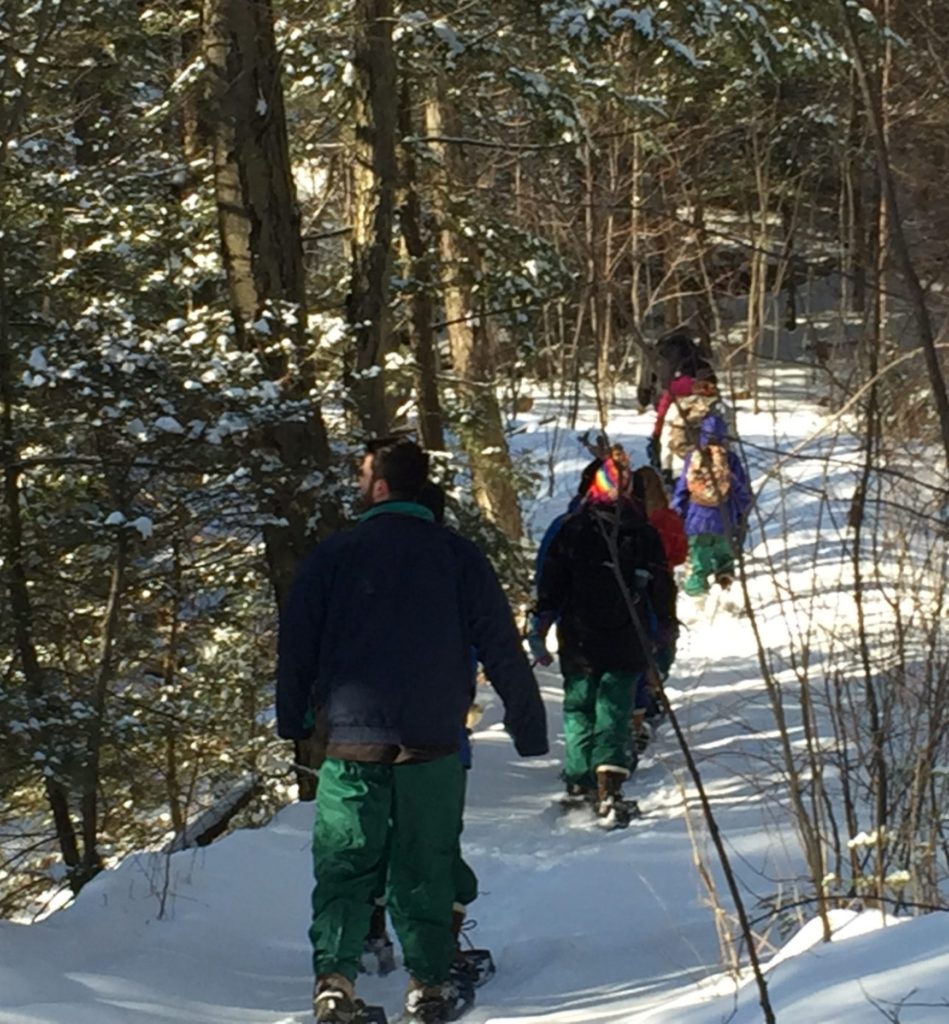
Start cold, vent, and layer break
Just when you are toasty warm and ready to start your hike, you should take off a layer and cool down. What??? While it seems counterintuitive, it’s a good idea to start out a little chilled before walking as exertion will quickly warm you up. If you remember the caution against sweating, starting cold will keep the moisture away. Then, when you start to heat up, vent to lower your temperature. Venting can include taking off your hat or gloves, unzipping overlayers or armpit zippers, or rolling up sleeves or cuffs—anything to keep from sweating. Once that’s not working to reduce sweating, stop for a layer break. It’s more effective to remove your insulating layer than your shell because snow melting on your puffy layer from your body warmth will make your I-layer wet.
Honor your turn-around time
Getting caught out overnight on a winter day hike is not recommended—at all. One way to avoid accidently hiking after dark is to establish a time when you will turn back on a hike and then stick to that time. I like to subtract one hour from the sunset time then divide my total hiking time in half to get my turn around time.
So for example, if the sun sets at 5 pm, I aim to be done the hike by 4 pm to have a little padding if anything goes wrong. Therefore, if I start the hike at noon, my turn-around time would be at 2 pm to get back to the trailhead safely. It’s very tempting when you are close to a desired sight or the summit to extend your turn-around time. Don’t do it! As skilled mountaineers will say, “reaching the summit is optional, getting down is mandatory.” Turn back and you’ll not have to worry about stumbling around in the dark as the temperature plummets. Besides, you’ll feel like a wise Everest climber.
Wrapping Up Winter Hiking Tips
I hope some of these winter hiking tips on how to dress, stay hydrated, use spiky equipment, and walk like rare birds will get you outside on more hiking trips in frigid and snowy conditions. The austere beauty of winter when ice crystals twinkle in the sunlight is worth every bit of the effort it takes to venture out.
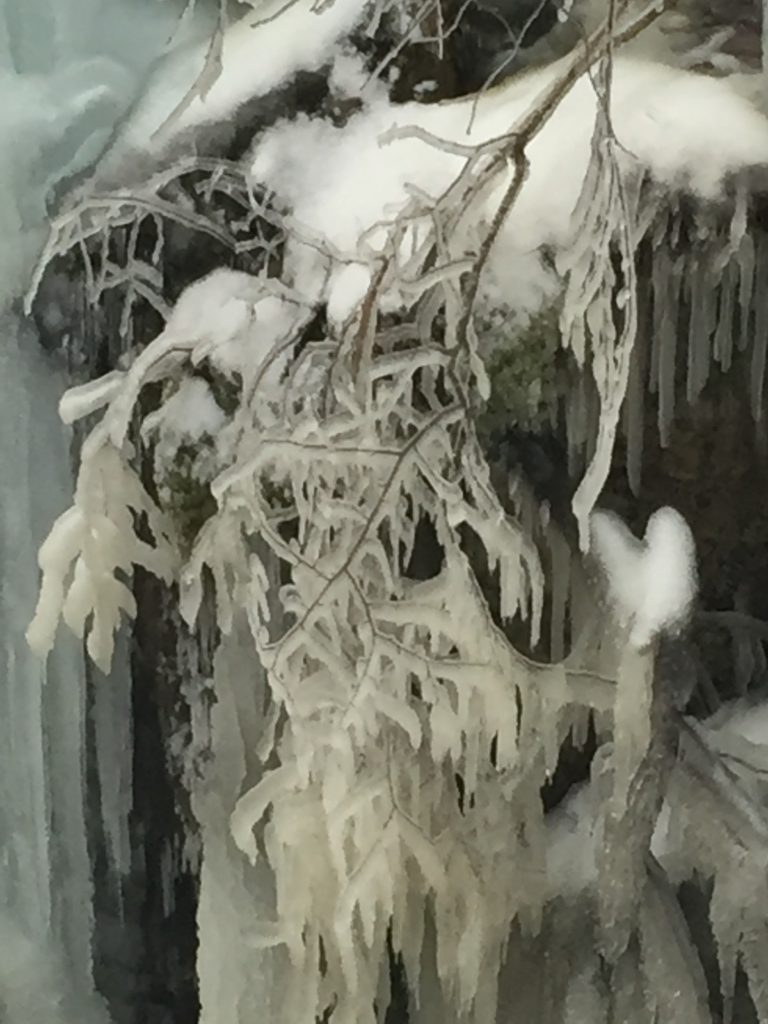
Like it? Pin it!
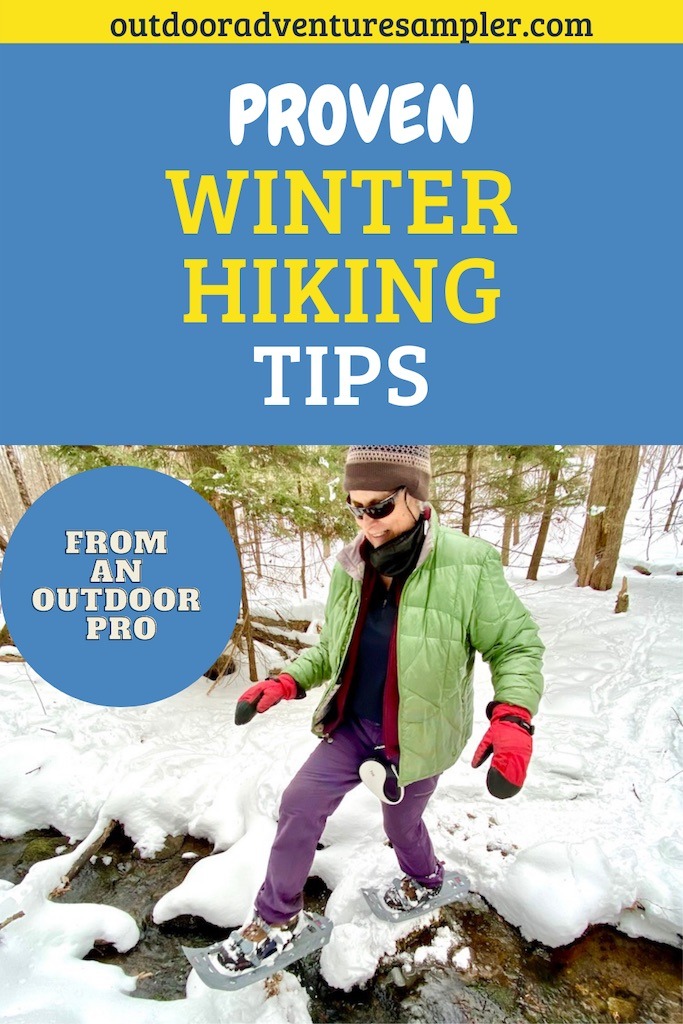
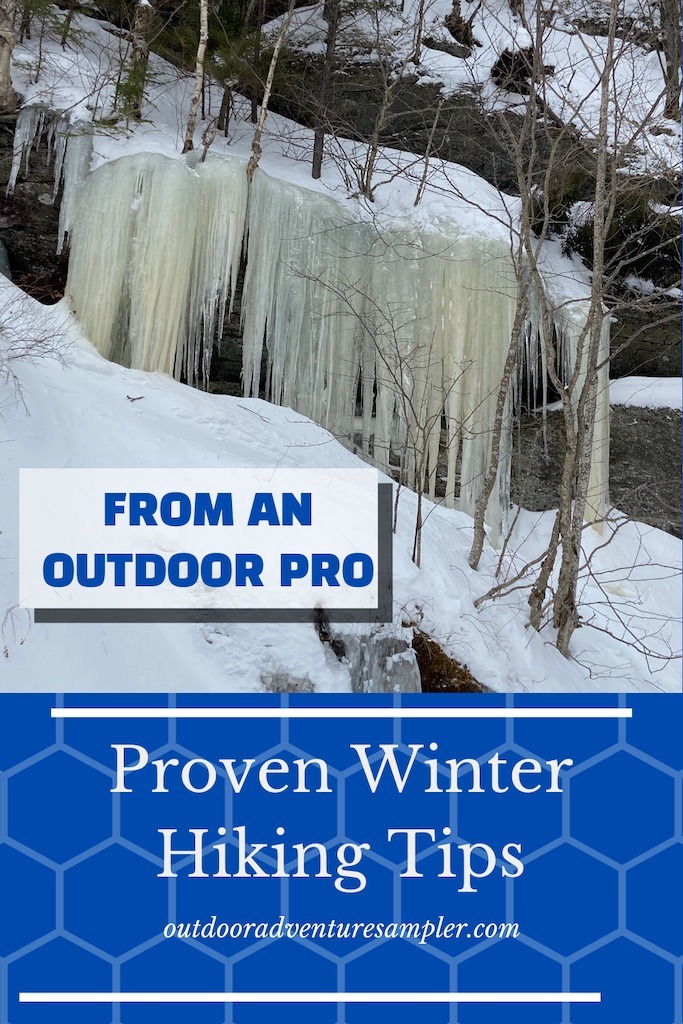



17 Comments
Susan Linton · January 14, 2020 at 6:19 pm
Love your photos and your WISE advice.
Karen · January 15, 2020 at 10:08 pm
Thanks Sue. WISE dress has gotten me through many winters. Thanks for reading.
Emma · January 17, 2020 at 11:56 pm
So many good tips in this post that I hadn’t thought of! As a hiker this is really useful!
Karen · January 18, 2020 at 11:21 am
Emma,
I’m so glad these are helpful. I tried to offer some from my experience that you don’t see on the standard hiking blogs.
Jessica · January 18, 2020 at 10:37 am
These tips are so helpful! Will definitely be referring back to these on my next winter vacation!
Karen · October 21, 2020 at 7:55 pm
So glad they are helpful. Have fun this winter
Karen · January 18, 2020 at 11:23 am
I hope these tips will keep you warmer on your next winter hike. Enjoy being outdoors!
Sophie · January 18, 2020 at 8:20 pm
These tips are so useful!! I’m such a clutz and so definitely need to take heed of these winter hiking tips.
Rowena · January 19, 2020 at 1:08 pm
Really great tips! Won’t lie, even though I know it, I always have a hard time taking clothes off in the cold. And then of course, I become that sweaty mess and it becomes even harder to take anything off.
Karen · January 20, 2020 at 7:35 pm
Rowena,
It is so tempting to stay warm and leave all layers on when you start. Makes for a quick stop right away to adjust. Happy hiking.
Josy · April 7, 2020 at 11:45 am
Great tips! I have loved getting out in the wintertime (although it is a bit less cold on this side of Canada.) I hadn’t heard of WISE, but it makes total sense.
The other advice that helped me is “be bold, start cold.” As when we snowshoe you get hot sooo quickly. I try to start of a little chilly, rather than wearing all my layers to start with and starting off sweaty.
Karen · April 7, 2020 at 9:40 pm
Josy,
I like that expression “be bold, start cold”. I haven’t heard it before. Obviously, I like easy mantras for outdoor skills so I’ll add that to my bag of tricks.
Kristen · November 10, 2020 at 12:32 pm
It’s snowing where I am today and I was just thinking about some new winter gear I need. This post is super helpful!
Annie · March 6, 2023 at 5:46 am
Excellent explanations for the befuddled!
After going with my husband to buy a warm outdoor jacket, I was left more than a little confused by the sales talk and product labelling. Thank you for explaining it simply.
While I can’t think of anything more boring than bingeing on netflix – and no, I haven’t tried it – nowadays I generally don’t go out in the cold if I don’t have to and can find something better to do. I had a working life outdoors and that was enough cold for me.
Pekka Honkakoski · March 31, 2023 at 3:15 pm
Great tips!
My videotips about winter stoves (14min 43sec).
Free to share, free to link.
https://vimeo.com/800496527
Pekka
Ultimate Guide to Gifts for the Outdoor Adventurer - · November 28, 2020 at 12:38 pm
[…] These chain link traction beauties make a winter hiker feel like Spiderman on an icy slope. I’ve used Kahtoola MICROspikes for many years and constantly rave about them. If you want to hear me wax poetic about them any more, click over to my post on winter hiking tips. […]
Best Cross Country Skiing Centers near Burlington · March 10, 2023 at 3:15 pm
[…] post on Proven Winter Hiking Tips will help you enjoy winter […]